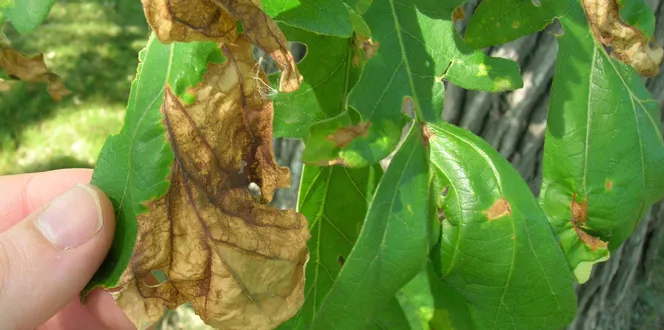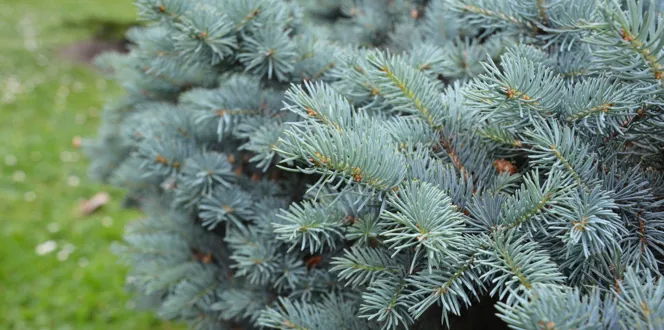Noticed brown leaves on your tree? Or perhaps your tree doesn’t seem to be growing much this year?
We’re here to help figure out what problem may be plaguing your tree. After caring for nearly every kind of tree over the last 135 years, we’re masters at identifying the most common tree problems.
Best of all, we have solutions for you! Scroll on to learn more. If you’re looking for more personalized info, hop over to our plant health care program page.
1. Lack of Mineral Recycling and Nutrients
Problem: Trees in our landscape frequently suffer from a lack of nutrients. In the forest, trees enjoy the benefits of nutrient-rich soil from decomposing leaves.
- In our yard, we remove fallen leaves, twigs, and bark. While this keeps our yard tidy, it also prevents these beneficial nutrients from being recycled into the soil.
- Plus, trees are often surrounded by grass, which outcompetes trees for available nutrients and water.
Solutions: Add nutrition back to the soil.
- Know when to fertilize your tree.
- Mulch your tree properly. As your organic mulch breaks down, it replenishes the soil with nutrients and microorganisms.
2. Compacted Soils
Problem: In our yards, trees often grow in compacted soil.
- Our yard is our backyard getaway. We run, play, walk, and enjoy our yard constantly.
- All that foot traffic, along with lawn mowers and construction projects, creates soil compaction. Plus, major soil compaction occurred when your house was built, so if your home is newer, it’s likely you’ll see this problem.
- Compacted soil leads to stressed soil, crushed root, and restricted root growth.
Solutions: Loosen the soil to reduce compaction and stress on trees.
Vertical mulching replaces soil in the root zone.
Mix in organic matter to amend compacted soil.
3. Opportunistic Pests
Problem: Stressed trees are more likely to be targeted by some pests.
- Often, there are three common causes of tree stress, which all boil down to a poor environment. Specifically, your tree may be planted in the wrong location, suffer from a lack of nutrients or not have access to enough resources.
- If trees are already struggling for nutrients and compete with nearby grass, this problem is compounded.
Solutions: Spot and treat tree pests and diseases early. Also, help relieve trees’ stress by following solutions #1 and #2
- Monitor trees for pests often.
- Phone your local arborist for treatment advice.
4. Mechanical and Natural Damage
Problem: Lawn equipment and animals can damage our trees.
- Deer and rabbits can do a number on your shrubs and trees.
- Plus, as we use lawn mowers and string trimmers, we can accidentally hurt tree trunks.
- When wounded by lawn equipment or hungry animals, these injuries interrupt trees' spread of water and nutrients.
Solutions: Check your trees regularly while prioritizing your trees’ long-term health.
- Inspect trees regularly to spot serious problems earlier.
- Boost your trees’ health by mulching, fertilizing and watering.
- Mix in organic matter to amend compacted soil.
5. Restricted Root Space
Problem: As trees grow, their expansive roots run into obstacles.
- When we plant those tiny tree saplings, they seemed far enough from the road.
- As trees grow, roots often spread well beyond the edges of its canopy.
- Then, they begin to run into barriers, such as buildings, roads, and sidewalks, that limit root growth.
Solutions: Remedy the soil. Give trees the essentials. Spot problem roots.
- Improve soil health.
- Properly feed your tree when necessary. Water your tree during dry spells and drought.
- See girdling roots, which grow around another root or trunk? Those restrict water and nutrients while weakening branches. Ask your arborist what you can do to fix them.





